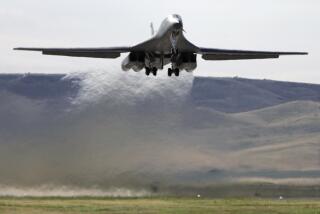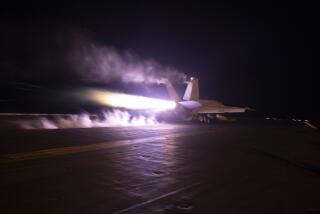British Fliers Suffering Higher Rate of Losses : Combat: Analysts cite the Royal Air Forceâs daring style and its hazardous mission as causes.
DHAHRAN, Saudi Arabia â British pilots, renowned for flying extremely low and fast at their targets, are suffering dramatically higher casualty rates than their American counterparts in Gulf War missions.
The relatively large number of British Tornado jets lost so far--five--is the result, military experts say, of both the Royal Air Forceâs daring flying style and the extremely hazardous mission they have been given by allied commanders: destroying the runways that serve Iraqâs air force.
In the complex web of tasks assigned the allied partners for the aerial dismantling of the Iraqi war machine--ranging from high-altitude carpet bombing of troops to medium-range attacks on military installations--the dangerous job of sweeping in close over heavily protected airfields and tearing up the runways has fallen primarily to the fabled RAF.
It is a job that makes the British Tornadoes and their crews sitting ducks for Iraqi antiaircraft barrages. Rather than fly at the relative safety of high altitude afforded many U.S. pilots, the British must go in low and maintain a steady course for the length of a runway while they dispense loads of specialized bombs.
It is the large number of these low-altitude missions being flown by their pilots, Britainâs own field generals say, that accounts for the fact that the RAF is losing a Tornado jet every 80 sorties, in contrast to the Americans, who are flying more than 750 missions for each downed aircraft.
âIt is a reflection of the nature of our flying, in that our tactics revolve around the low-level tactic,â Air Vice Marshal Bill Wratten said Tuesday. âThat is not to say that these have been losses to enemy action, but low flying is an inherently dangerous business, as we all know.â
Phillip Mitchell, a military analyst with Londonâs International Institute of Strategic Studies, said the British Tornadoes âhave been alloted a particular role within the alliance, and that role is perhaps one of the most dangerous roles there could be, and the primary reason that so far weâve lost so many Tornadoes in action.â
The RAF is famous within the North Atlantic Treaty Organization for its brash, brazen combat style: flying in groups of two or three aircraft low and fast over the terrain, hitting the target and streaking out again. American pilots, by contrast, tend to go into a combat zone in large groups, covered by protective fire that busts holes in enemy air defenses.
âThe RAFâs general philosophy is flying in very, very low and fast in small packets,â said Mark A. Lorell, a senior analyst at the RAND Corp. âAmericans believe in medium altitude and large groups of aircraft.â
A big factor in British strategy in Operation Desert Storm, military analysts say, is their high-tech JP-233, a state-of-the-art, runway-busting cluster bomb that is among the most advanced weapons in the British arsenal.
While ordinary âairfield-denialâ weapons may chop up enemy runways, the 1,000-pound JP-233 delivers a double dose of destruction: dozens of scattered bomblets that crater the runway asphalt. Then, to prevent bulldozers from simply coming in and repairing the mess, a packet of more than 200 delayed-action mines concealed in the debris will blow up anything that ventures onto the runway later.
Under NATO strategy, such runway destruction is one of the critical tasks assigned to the British even in Europe.
The JP-233 has made Britainâs Tornado GR-1 attack fleet an effective airfield killer--the British fliers have gone after 40 Iraqi runways so far with considerable success.
But the down side is that it must be delivered by pilots flying straight down the runway at extremely low altitudes--as low as 100 to 200 feet--in full range and view of enemy antiaircraft guns. Experts say the pilots cannot even take evasive action to avoid enemy fire if they want to complete their mission successfully.
âYou can see that this is obviously dangerous,â said Squadron Leader Philip Bradshaw, RAF spokesman in the Saudi capital, Riyadh. âIf you say that the British are doing the dangerous part and everybody else is doing the easy part, no, thatâs not true. But under certain circumstances, you have to put yourself in a slightly more hazardous situation in order to do the job. . . .â
British officials have stopped short of blaming their downed aircraft on their vulnerability to enemy fire. Rather, they refer only to the hazards of low-altitude flying and leave open the possibility that their aircraft losses could have resulted simply from running into the ground or suffering mechanical failure with too little altitude to spare.
âWhat I am saying is that low flying is inherently more hazardous than flying at higher levels, for reasons which are largely self-evident,â Wratten told reporters. âIf one does suffer a difficulty, then one is that much closer to the ground.â
âOur tactics will develop and evolve as the campaign progresses,â the British air commander added, âbut we have suffered a high rate of attrition in comparison with the other air forces--there is no denying that.â
There have been no official causes released for Britainâs downed aircraft. However, all of them have been from among the Tornado GR-1 ground attack fleet, as opposed to the Tornado F-3s and Jaguar fighters that also make up the RAF force in Saudi Arabia. News reports say four of the Tornadoes were lost to enemy fire and one in an accident.
Officials of the United States, which has lost nine aircraft as a result of hostile causes, said it is true that British pilots are flying a large number of low-altitude missions, but so, they say, do other aircraft. American A-10s, for example, dive in low over enemy tanks and strike them with huge 30-millimeter guns.
American planes may also be delivering classic, non-guided bombs from dangerous low dives, or ferrying in cluster bombs at relatively low altitudes, said a U.S. Defense Department spokesman, who asked not to be named.
âCertainly, airfields would be among the more heavily defended targets, but certainly not the only ones. We have all seen videotape on (Cable News Network) of what it looks like over Baghdad,â he said.
Officials on all sides of the coalition say the total number of allied aircraft downed, 19 in more than 10,000 sorties, is extremely low, for all members of the coalition.
âOverall losses have been incredibly low, astonishingly low, considering the number of sorties flown and the coordination which has surrounded those sorties,â Wratten said. âI will say we have also been extremely unlucky, and bad luck does not last forever.â
BRITISH JET LOSSES
British Tornadoes have been suffering higher losses proportionately than American planes among the allies. Royal combination of bad luck and riskier tactics:
A Tornado GR-1 bomber crashed Tuesday, the fifth since the start of hostilities last week. The fate of the two-man crew was not known.
The Tornadoes specialize in low-altitude raids, lower than American tactics dictate.
The RAF has 36 Tornadoes in Saudi Arabia, 24 of them the low-flying GR-1. The Italians and Saudis also fly the Tornado.
More to Read
Sign up for Essential California
The most important California stories and recommendations in your inbox every morning.
You may occasionally receive promotional content from the Los Angeles Times.










